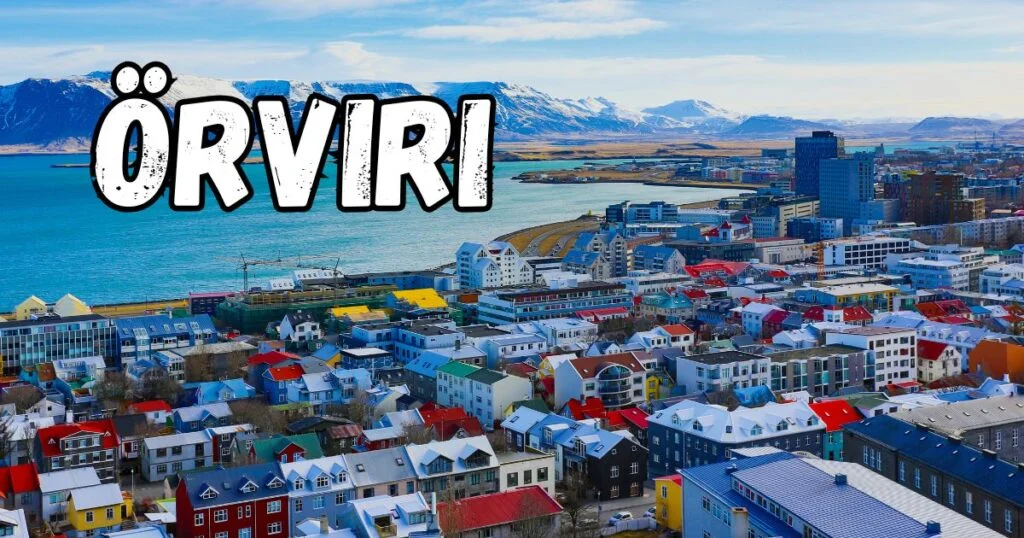Örviri, a concept steeped in ancient Nordic culture, particularly Icelandic traditions, embodies profound spiritual, cultural, and practical significance. Deriving from the Icelandic words “ör” (arrow) and “virki” (fortification), it translates to “arrow fortification.” This intriguing term holds connections to mythology, architecture, and healing practices. Let’s delve into its multifaceted history and applications.
What is Örviri?
At its core, örviri symbolizes protection and resilience. Historically, it has been a spiritual safeguard against adversities—be it supernatural entities, natural calamities, or misfortune. The upward arrow with three intersecting horizontal lines often represents örviri, uniting the elements of sky, land, and sea under a protective force.
While rooted in ancient beliefs, örviri’s applications extend beyond spirituality. It finds expression in architecture, appearing as protective symbols on buildings, and even influencing modern wellness practices.
Origins and Historical Significance
Örviri’s roots trace back to Icelandic sagas and Norse mythology, where it was a symbol of unity and courage. In ancient tales, örviri was associated with heroes who united clans through bravery and wisdom. Scholars link it to Odin, the Norse god of knowledge, whose ravens Huginn and Muninn symbolized thought and memory. This connection reinforces örviri’s role as a tool for insight and protection.
The term evolved from its early usage in sagas to signify fortification and cohesion, reflecting the broader cultural ethos of Icelandic communities.
Meaning and Modern Interpretation
In contemporary contexts, örviri transcends its mythological origins to embody intelligence, protection, and spiritual depth. The literal translation, “overseer” or “guardian,” aligns with its modern usage to describe insightful, knowledgeable individuals or profound ideas.
Its meaning also extends to education and intellectual growth, resonating as a metaphor for enlightenment and resilience in challenging times.
The Practice of Örviri
Örviri’s practices integrate spirituality and connection with nature, emphasizing mindfulness, meditation, and shamanistic rituals. These practices focus on tapping into the energies of the natural world—whether through ceremonies, spending time outdoors, or using tools like drums and herbs.
Key aspects include:
- Shamanism: Shamans use rituals to connect with spirits for guidance and healing.
- Nature Meditation: Practitioners immerse themselves in natural settings, fostering mindfulness and harmony with the environment.
- Holistic Healing: Örviri incorporates herbal remedies and physical movements to enhance well-being.
Benefits and Challenges of Örviri
Benefits:
- Mental Wellness: Helps reduce anxiety, stress, and enhances mindfulness.
- Physical Health: Supports pain relief, better digestion, and improved sleep.
- Spiritual Growth: Encourages deeper self-awareness and connection with nature.
- Cultural Preservation: Revives ancient practices, fostering a sense of identity.
- Challenges:
- Misunderstandings: Its spiritual roots can be misinterpreted as superstition.
- Accessibility: Requires knowledge of rituals and tools, which may not be widely available.
- Cultural Sensitivity: Risk of misappropriation if not practiced respectfully.
Comparisons with Other Practices
Örviri shares similarities with practices like acupuncture and Reiki but stands apart in its intuitive and holistic approach. Unlike acupuncture’s structured energy points, örviri’s rituals are guided by natural intuition and the practitioner’s connection to the environment. Compared to Reiki, it does not require formal attunements, relying instead on innate spiritual resonance.
Misconceptions About Örviri
Due to its ancient origins, örviri is often misunderstood:
- It is not a mythical creature but a symbolic and practical tradition.
- It does not grant supernatural abilities but enhances mindfulness and protection.
- Its practices, while spiritual, are deeply rooted in real-world applications.
Personal Experiences
Many practitioners report transformative experiences with örviri:
- Connection to Nature: Heightened awareness and appreciation of the environment.
- Inner Peace: Enhanced clarity and reduced stress.
- Creativity: Greater freedom of expression and new perspectives.
- Physical Benefits: Improved flexibility, posture, and overall health.
Conclusion
Örviri is more than a relic of Icelandic tradition; it is a living practice that bridges the past with the present. Its focus on protection, mindfulness, and connection to nature resonates deeply in an era seeking holistic well-being. By embracing örviri, individuals can explore a unique path to physical, mental, and spiritual harmony while honoring an ancient cultural legacy.
FAQs
1. What does “örviri” mean?
Örviri is an Icelandic term that translates to “arrow fortification.” It symbolizes protection and is rooted in Norse mythology and Icelandic cultural traditions.
2. Where did örviri originate?
Örviri originated in ancient Nordic culture, particularly in Iceland. Its roots are tied to Icelandic sagas, Norse mythology, and traditional practices that emphasize protection and harmony with nature.
3. What is the purpose of örviri?
Historically, örviri served as a protective symbol or object believed to ward off negative forces, illnesses, and supernatural entities. It also represents unity among the elements of nature: sky, land, and sea.
4. Is örviri still relevant today?
Yes, örviri remains relevant in modern Icelandic culture. It is often seen in architectural designs, protective talismans, and as a spiritual practice focusing on mindfulness and harmony with nature.
5. How is örviri connected to Norse mythology?
Örviri is thought to draw inspiration from Norse mythology, particularly from symbols and practices tied to protection, unity, and wisdom. Some scholars associate it with Odin, the Norse god of knowledge and protection.
6. What does the symbol of örviri look like?
The most common depiction of örviri is an upward-pointing arrow intersected by three horizontal lines. These lines represent the sky, land, and sea, symbolizing unity and protection across nature’s elements.
7. How is örviri practiced?
Practicing örviri involves rituals, ceremonies, and connecting with nature. It can include meditative techniques, spiritual tools (such as herbs or symbols), and mindful engagement with the natural world.
8. How is örviri different from other spiritual practices?
Unlike some spiritual traditions that require initiation or specific tools (like Reiki or acupuncture), örviri emphasizes intuitive practices and personal connections to nature and surroundings.
9. Can anyone practice örviri?
Yes, örviri is accessible to anyone interested in connecting with nature, practicing mindfulness, and exploring its protective and spiritual elements.
10. Does örviri have modern applications?
Today, örviri’s principles influence mindfulness practices, holistic healing methods, and even eco-conscious architectural designs.
Stay engaged for continuous updates and important news: Internet Chicks
